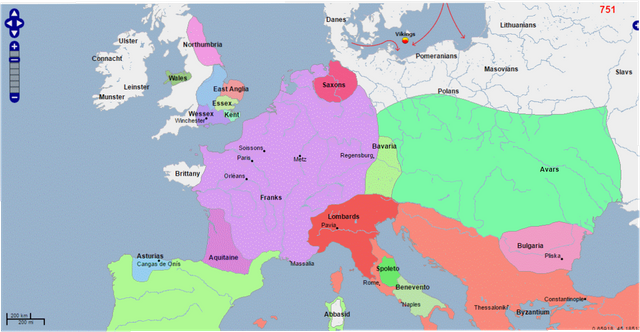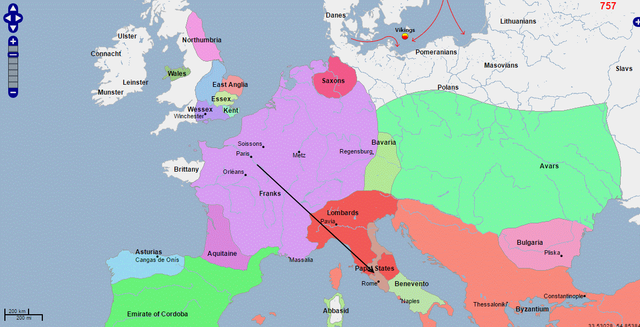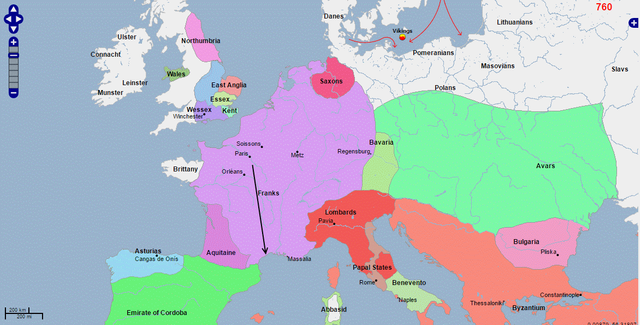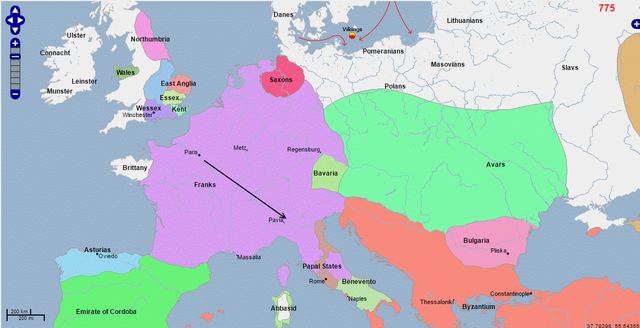The political evolution of the Carolingian Empire – Part 2: Utter Dominance
The Carolingian Empire ascends to new, never seen, highs but also begins its inevitable fall.
In the course of this series, you will discover the political history behind one of the greatest empires Europe has ever seen.
In part 1 of these series, we left off in the fall of the Merovingian puppet king Childeric III and the rise of Pepin I, who founded a new dynasty of Frankish kings, the Carolingians.

Carolingian Realm (Purple) upon Pepin I's coronation in 751 C.E.
Source: Geacron: Interactive World History Atlas since 3000 BC
During his rule Pepin I made several military campaigns into Alemania, bringing her into his Empire.
Unlike his father, Charles Martel, Pepin considered the Pope as an important figure, as such, when the Lombards threatened Rome and Pope Stephen II crossed the Alps to ask Pepin I for help, he answered the Pope’s call.
This action proved to be an emancipation call from the Pope towards the Byzantine Emperor to whom he was subject. This fact was due to the Pope being required to have the Emperor’s approval to be able to consecrate. Anyhow, I will address this particularity in another article.
Despite the Saint Peter’s descendent visit to the Frankish lands, the Frankish aristocracy was reluctant to enter a war with the Lombards, and it would take an Imperial gathering in Quierzy to seal the alliance between Pepin and the Pope. This was a serious political statement as it solidified Pepin’s legitimacy as king of the Franks.
As such, Pepin crossed the Alps and defeated the Lombards, returning the conquered Papal Lands. However, this would not stop the Lombards to invade again and, in 756, Pepin returned and defeated the Lombard King Aistulf forcing him to not only return the conquered land but also pay tribute to the Franks.

Liberation of the Papal Lands by Pepin I.
Source: Geacron: Interactive World History Atlas since 3000 BC
This donation of Papal Lands was the founding pillar of the future Papel States. Ironically their donation came from a Frankish King, not from Constantine, an argument that Gregory VII will use in 1075 to legitimate the “Empire of the Papacy.”
Pepin also made several military campaigns in the South capturing the Muslim territories of Narbonne (760) and enforcing a pro-Frankish peace treaty in a warring Aquitaine.

Conquest of Narbonne, in 760 C.E, from the Muslims.
Source: Geacron: Interactive World History Atlas since 3000 BC
Eight years after (768), the Frankish realm would meet a new division as Pepin died and the Kingdom was divided between is two sons, Carloman and Charles, also known as Charlemagne.
According to Salic law upon one’s death, the kingdom should be equally divided among his children, and Pepin took this quite literally, giving each child a territorial hold in the different areas of his realm: Austrasia, Neustria, Burgundy, and Aquitaine, resulting in a peculiar political map.
Partition of the Frankish Empire between Pepin's sons, Charles (Carlos) and Carloman.
By V.A. Alvarez Palenzuela in Historia Universal De La Edad Media
If you recall correctly from my previous post since Clovis I the tradition to divide the kingdom between one’s sons was the cause of political instability, and with Charlemagne and his brother Carloman, it was no different.
The conflict between the two brothers only did not escalate to all-out war due to Carloman’s young death, at the age of 20, in 771. As such, Charlemagne was crowned sole king of the Franks bringing the Empire to a Golden Age that Europe had not seen since the Roman Empire almost 700 years before.
Regarding political gains, King Charles made several successful military campaigns. First, he consolidated the tradition Frankish holdings, subduing the Duke of Aquitaine, then, when the Pope Adrian I called him for help as the Lombard King Desiderius was invading Papal Lands, he crossed the Alps and conquered the Lombards crowning himself as King of these peoples in 774, in Pavia.

Conquest of the Lombard Kingdom. 774 C.E
Source: Geacron: Interactive World History Atlas since 3000 BC
He also made campaigns against the Saxons, whom he intended to not only subdue but also Christianize, conquering them after 12 years of war (773-785). This war showed that King Charles could also be ruthless, as he ordered the execution of 4,500 Saxon prisoners (Verdun Massacre) when the Saxons rebelled and refused to convert to Christianity.

Conquest of the Saxon Tribes, 785 C.E.
Source: Geacron: Interactive World History Atlas since 3000 BC
Furthermore, he sought to expel the Muslim menace from the Iberian Peninsula, and as such made several campaigns into the Islamic territories. Those resulted in the conquest of the March of Barcelona (Marca Hispanica), in 801, which I briefly mentioned in this article.

Conquest of the Marca Hispanica, 801 C.E.
Source: Geacron: Interactive World History Atlas since 3000 BC
Charlemagne’s reign was one of Cultural and Economic Revival, were classical knowledge was restored and copied, education gained importance, commercial production organized itself around proto-cities and monasteries, weights and measures were regulated, and coinage was reformed. Also, Charles maintained good relations with the Pope organizing its territory into provinces which were ruled by Archbishops, who then ruled over various dioceses, an organization that the Roman Apostolic Church still utilizes to his day. I must add that this type of structure was implemented in the Late Roman Empire, but it was done in a very rudimentary way, and it was with Charlemagne that this became an organizational principle within the Roman Church.
Thus Charles earned his title of “The Great” due not only to his military and political achievements but also due to his cultural “renaissance” that was a major stepping stone to the Fifteen-century renaissance.
However, at Rome, a dangerous political coup was rising. When Pope Adrian I died, Leo III succeed to him, but he found that we had very little support in the Papal court, so, before long, he had charges of pursuing an immoral life which led to a coup being staged to remove him from power. This development forced him to flee to Charlemagne’s court, who in return marched on Rome.
This way, Charlemagne had a serious advantage as he could use the Pope to advance his goals of becoming Emperor of the Romans, and so he did being crowned Roman Emperor, in 800, in Rome, by Pope Leo the III, thus marking the beginning of an Empire that would define the History of Europe for 1000 years.

Imperial Coronation of Charlemagne, by Friedrich Kaulbach, 1861.
But death was near for Charles, and so the Salic Law was, yet again, put to practice. However, this time was different. Charles knew that the old Frankish tradition would only fragment the Empire and precipitate to violence and conflict between his sons, so he decided, in 806, to, nonetheless, divide the kingdom, but with a twist, he would give the majority of the Carolingian Empire to one of his sons and not an equal share to all as tradition ruled.

Partition of the Carolingian Empire between Charlemagne's sons: Pepin (Pipino), Charles (Carlos) and Louis (Luís).
By V.A. Alvarez Palenzuela in Historia Universal De La Edad Media
However, two of the three children (Pepin the Hunchback and Charles the Young) of Charlemagne died before he did, and so in 812, a year before his death, he drafted a final division giving his son Louis, later known as "The Pious" the majority of the Land and giving his grandson, Bernard (Son of Pepin), the territory that was deemed for his father, Italy.
Moreover so, with Charlemagne’s death in 813 and the rise of his son, Louis, as King of the Franks, the downfall of the Carolingian Empire was set in motion, being a victim, ironically, to what led them to power, as the further and further divisions of the Empire eroded Imperial Unity.
Would you like to know more about Charlemagne? Click here and buy cheap books with free shipping!
Sources:

Fried, J. (2015). The Middle Ages. London, England: The Belknap Press of Harvard University Press.
Palenzuela, V. A. (2002). Historia Universal De La Edad Media . Ariel.
Disclaimer: This is a repost of an article you can found on my personal blog https://warandtaxes.wordpress.com/.